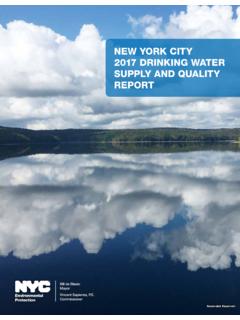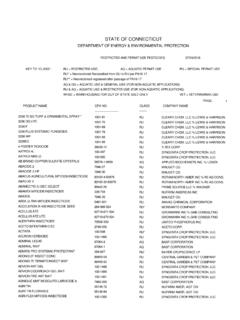Transcription of 1,4-Dioxane - United States Environmental Protection Agency
1 United States Office of Land and Emergency EPA 505-F-17-011 Environmental Protection Agency Management (5106P) November 2017 1 Technical Fact Sheet 1,4-Dioxane November 2017 Introduction This fact sheet, developed by the Environmental Protection Agency (EPA) Federal Facilities Restoration and Reuse Office (FFRRO), provides a summary of the emerging contaminant 1,4-Dioxane , including physical and chemical properties; Environmental and health impacts; existing federal and state guidelines; detection and treatment methods; and additional sources of information. This fact sheet is intended for use by site managers who may address 1,4-Dioxane at cleanup sites or in drinking water supplies and for those in a position to consider whether 1,4-Dioxane should be added to the analytical suite for site investigations. 1,4-Dioxane is a likely human carcinogen and has been found in groundwater at sites throughout the United States .
2 The physical and chemical properties and behavior of 1,4-Dioxane create challenges for its characterization and treatment. It is highly mobile and does not readily biodegrade in the environment. What is 1,4-d ioxane? 1,4-Dioxane is a synthetic industrial chemical that is completely miscible in water (EPA 2006; ATSDR 2012). Synonyms include dioxane , dioxan, p- dioxane , diethylene dioxide, diethylene oxide, diethylene ether and glycol ethylene ether (EPA 2006; ATSDR 2012; Mohr 2001). 1,4-Dioxane is unstable at elevated temperatures and pressures and may form explosive mixtures with prolonged exposure to light or air (EPA 2006; HSDB 2011). 1,4-Dioxane is a likely contaminant at many sites contaminated with certain chlorinated solvents (particularly 1,1,1-trichloroethane [TCA]) because of its widespread use as a stabilizer for chlorinated solvents (EPA 2013a; Mohr 2001).
3 Historically, the main use (90 percent) of 1,4-Dioxane was as a stabilizer of chlorinated solvents such as TCA (ATSDR 2012). Use of TCA was phased out under the 1995 Montreal Protocol and the use of 1,4-Dioxane as a solvent stabilizer was terminated (ECJRC 2002; NTP 2016). Lack of recent reports for other previously reported uses suggest that many other industrial, commercial and consumer uses were also stopped. At a Glance Flammable liquid and a fire hazard. Potentially explosive if exposed to light or air. Found at many federal facilities because of its widespread use as a stabilizer in certain chlorinated solvents, paint strippers, greases and waxes. Short-lived in the atmosphere, may leach readily from soil to groundwater, migrates rapidly in groundwater and is relatively resistant to biodegradation in the subsurface.
4 Classified by EPA as likely to be carcinogenic to humans by all routes of exposure. Short-term exposure may cause eye, nose and throat irritation; long-term exposure may cause kidney and liver damage. Federal screening levels, state health-based drinking water guidance values and federal occupational exposure limits have been established. Modifications to existing sample preparation procedures may be required to achieve the increased sensitivity needed for detection of 1,4-Dioxane . Common treatment technologies include advanced oxidation processes and bioremediation. No federal maximum contaminant level (MCL) has been established for 1,4-Dioxane in drinking water. Disclaimer: The EPA prepared this fact sheet using the most recent publicly-available scientific information; additional information can be obtained from the source documents.
5 This fact sheet is not intended to be used as a primary source of information and is not intended, nor can it be relied on, to create any rights enforceable by any party in litigation with the United States . Mention of trade names or commercial products does not constitute endorsement or recommendation for use. TECHNICAL FACT SHEET 1,4-Dioxane 2 Technical Fact Sheet 1,4-Dioxane It is a by-product present in many goods, including paint strippers, dyes, greases, antifreeze and aircraft deicing fluids, and in some consumer products (deodorants, shampoos and cosmetics) (ATSDR 2012; Mohr 2001). 1,4-Dioxane is used as a purifying agent in the manufacture of pharmaceuticals and is a by- product in the manufacture of polyethylene terephthalate (PET) plastic (Mohr 2001). Traces of 1,4-Dioxane may be present in some food supplements, food containing residues from packaging adhesives or on food crops treated with pesticides that contain 1,4-Dioxane (ATSDR 2012; DHHS 2011).
6 Exhibit 1: Physical and Chemical Properties of 1,4-Dioxane (ATSDR 2012) Property 1,4-Dioxane Chemical Abstracts Serv ice (C AS) number 123-91-1 Physical description (physical state at room temperature) Clear, flammable liquid with a faint, pleasant odor Molecular weight (g/mol) Water solubility Miscible Melting point (oC) Boiling point (oC) at 760 mm Hg Vapor pressure at 25oC (mm Hg) Specific gra vity Octanol-water partition coeffi cient (l og Kow) -0 .27 Organic carbon partition coefficient (l og Koc) Henry s law constant at 25 oC (atm-m3/mol) X 10-6 Abbreviations: g/mol grams per mole; oC degrees Celsius; mm Hg millimeters of mercury; atm-m3/mol atmosphere-cubic meters per mole Existence of 1,4-Dioxane in the environment 1,4-Dioxane is typically found at some solvent release sites and PET manufacturing facilities (ATSDR 2012; Mohr 2001).
7 It is short-lived in the atmosphere, with an estimated 1- to 3-day half-life due to photooxidation (ATSDR 2012; DHHS 2011). Migration to groundwater is weakly retarded by sorption of 1,4-Dioxane to soil particles; it is expected to move rapidly from soil to groundwater (EPA 2006; ATSDR 2012). It is relatively resistant to biodegradation in water and soil, although recent studies have identified degrading bacteria (Inoue 2016; Pugazhendi 2015; Sales 2013). It does not bioaccumulate, biomagnify, or bioconcentrate in the food chain (ATSDR 2012; Mohr 2001). 1,4-Dioxane is frequently present at sites with TCA contamination (Mohr 2001; Adamson 2014). It may migrate rapidly in groundwater, ahead of other contaminants (DHHS 2011; EPA 2006). Where delineated, 1,4-Dioxane is frequently found within previously delineated chlorinated solvent plumes and existing monitoring networks (Adamson 2014).
8 As of 2016, 1,4-Dioxane had been identified at more than 34 sites on the EPA National Priorities List (NPL); it may be present (but samples were not analyzed for it) at many other sites (EPA 2016b). 3 Technical Fact Sheet 1,4-Dioxane What are the routes of exposure and the potential health effects of 1,4-Dioxane ? Exposure may occur through ingestion of contaminated food and water, or dermal contact. Worker exposures may include inhalation of vapors (ATSDR 2012; DHHS 2011; EU 2002). Potential exposure could occur during production and use of 1,4-Dioxane as a stabilizer or solvent (DHHS 2011; EU 2002). Short-te rm exposure to high levels of 1,4-Dioxane may result in nausea, drowsiness, headache, and irri tation of the eyes, nose and throat (ATSDR 2012; EPA 2013b; NI OSH 2010; EU 2002). 1,4-Dioxane is readily absorbed th rough the lungs and gastrointestinal tract.
9 Some 1,4-Dioxane may also pass th rough the skin, but studies indicate th at much of it will evaporate before it is absorbed. Distribution is rapid and uniform in the lung, liver, kidney, spleen, colon and skeletal muscle tissue (ATSDR 2012). 1,4-Dioxane is weakly genoto xic and reproductive eff ects in humans are unknown; however, a developmental stu dy on rats indicated that 1,4-Dioxane may be slightly toxic to the developing fetus (ATSDR 2012; Gi avini and others 1985). Animal stu dies showed increased incidences of nasal cavity, liver and gall bladder tu mors after exposure to 1,4-Dioxane (ATSDR 2012; DHHS 2011; EPA IR IS 2013). EPA has classified 1,4-Dioxane as li kely to be carcinogenic to humans by all routes of exposure (EPA IR IS 2013). The U. S. Department of Health and Human Services States that 1,4-Dioxane is reasonably anticipated to be a human carcinogen based on sufficient evidence of carcinogenicity from studies in experimental animals (DHHS 2011).
10 The National In stitu te for Occupational Safety and Health (NI OSH) considers 1,4-dio xane a potential occupational carci nogen (NI OSH 2010). The European Union has classified 1,4-Dioxane as having limited evidence of carcinogenic effect (EU 2002). Are there any federal and state guidelines and health standards for 1,4-Dioxane ? EPA s Integrated Risk Information System (IRIS) database includes a chronic oral reference dose (RfD) of milligrams per kilogram per day (mg/kg/day) based on liver and kidney toxicity in animals and a chronic inhalation reference concentration (RfC) of milligrams per cubic meter (mg/m3) based on atrophy and respiratory metaplasia inside the nasal cavity of animals (EPA IRIS 2013). The cancer risk assessment for 1,4-Dioxane is based on an oral slope factor of mg/kg/day and the drinking water unit risk is x 10-6 micrograms per liter ( g/L) (EPA IRIS 2013).













